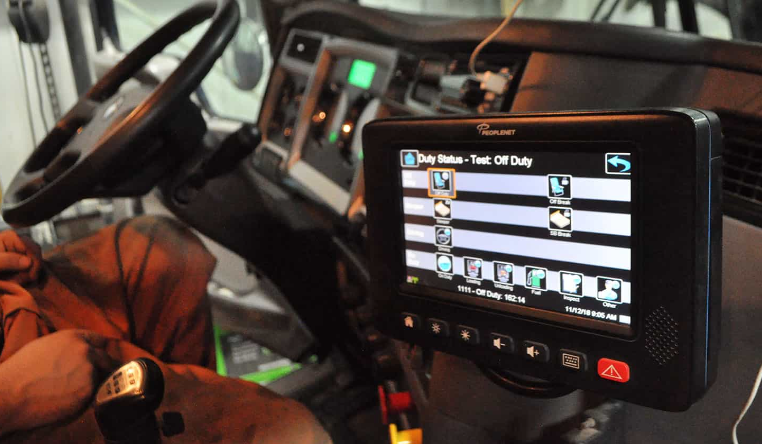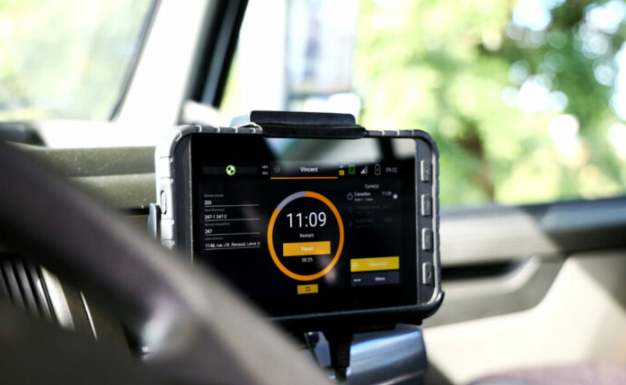Best ELD Management Solution for Trucks to Improve Efficiency
In recent years, companies have massively adopted electronic logging devices, also known as ELDs, for trucking. This growth is owed to the increasing need for improvement in fleet management services. And the altering regulatory requirements have also contributed to this growth.
With the growth of EL devices, ELD management becomes inevitable. Here is a detailed look into the essential tips for success in managing ELD for trucks.
Part 1: Everything You Need to Know about Electronic Logging Devices
An electronic logging device(ELD) in trucking is a hardware piece utilized by drivers of fleet management companies or commercial motor vehicles.
The purpose of these devices is the automated recording of driving time and HOS (Hours of Service). These devices can be plugged into the vehicle's onboard diagnostics port (OBD), capturing data on its location, engine, speed and covered distance.

The key features and functions of an ELD management system are as follows:
- Internal synchronization with the engine control module.
- Automated recording of driving details and timing.
- Location recording.
- Transference of electronic data either via telematics (wireless or email) or local (USB or Bluetooth).
- Prevention of tampering.
- Certification of driver records.
- Displaying of reports for safety officials on demand.
- User manual.
- Audio Controls such as volume control and mute.
Part 2: Who Needs to Comply with the ELD Mandate?
The federal ELD mandate is meant to be in place to improve safety for drivers and make it easier for drivers to track their hours of service. According to the FMCSA, the ELD mandate will be able to prevent 1844 crashes and save approximately 26 lives every year.
Even though the ELD rule applies to many commercial vehicle drivers, there are some exceptions to this list:
Short-haul Drivers: Short-haul drivers are those who transport goods within an air radius of 150 miles or their usual work reporting location. These are the drivers that go off within 14 hours of duty.
Vehicles Built before 2000: Vehicles manufactured before 2000 or earlier do not have an Engine Control Module known as an ECM, which is required for an ELD. In case you operate a vehicle built before 2000, it is exempted from the ELD mandate.
Drivers with Equal to or Less than 8 Days of RODS: Drivers who maintain RODS for 8 days or less within 30 days are exempted from the ELD rule.
Towaway Drivers: Towaway drivers are also not required to have an EDL installed inside their CMV as they are just driving these vehicles on a temporary basis.
Farm and Agricultural Vehicles: Livestock and farm vehicles also do not require to have an ELD installed unless they are traveling beyond the 150-mile radius.
Vehicle Size: Vehicles below the size of 10,000 lbs. also do not require an ELD.

Part 3: Managing ELDs with the AirDroid Business MDM Solution
Electronic logging devices(ELDs) are helping fleet companies improve several aspects of their operations, from safety and compliance to fuel consumption and preventive maintenance. Many organizations hope to find an effective ELD management solution to improve the efficiency and effectiveness of their fleet operations and maximize the safety and productivity of drivers.
AirDroid Business MDM solutions are one of the best in the market. ELD management becomes a breeze with AirDroid's latest technology, ensuring that your Android endpoints remain stable and lets your business function super smoothly.
1 ELD Application Management
The regulations are changing, and ELD apps need to keep up. Any changes to the rules will require the software provider to make changes to their ELD applications. It's time-consuming to manage a large number of applications efficiently and effectively. With AirDroid Business MDM, trucking companies can remotely install the updated ELD app on the entire fleet of mobile devices. Moreover, for the applications installed in your ELDs, you can schedule an update that falls after working hours to avoid any interruptions. You can also uninstall one or all the apps whenever necessary.
2 Automated Alerts and Workflows
Trucking companies need to keep an eye on the behavior of all managed enterprise devices. With AirDroid Business MDM, when there is irregular behavior, fleet managers can receive an instant notification. There are nearly 20 types of alerts available, including cellular data usage alerts, device online/offline alerts, Kiosk on/off alerts, and so on. Companies can remotely view the mobile data usage of drivers on the road to determine internet overuse or misuse. A workflow can auto-execute assigned actions after the device triggers the Geofence alerts. Fleet management companies can achieve higher efficiency by continuously improving their workflows.
3 Lockdown Devices with Kiosk Mode
ELD apps need to be turned on from the moment drivers start their journey to track information. With AirDroid Business MDM, devices can be locked single or multi-app mode that only runs the logging software. Keeping the drivers away from accessing other mobile apps and running the ELD app front and center creates a focused driving experience. Now drivers can focus on what's important - making delivery on-time and using company apps the way they are intended to for better productivity and effective work.
4 Locate Drivers or Delivery Easily
Equipping an Android device with GPS tracking on a vehicle allows trucking companies to monitor device location and route activities for each driver. With AirDroid Business MDM, trucking companies can locate drivers' devices in real-time locations anytime and anywhere. Moreover, companies can trace the history of device locations and paths within a certain time frame. With its constant connectivity option, AirDroid Business helps companies to idle time, and better routes, and overall productivity can be improved by analyzing the data on a consistent basis.
Part 4: Useful Practices for Effective ELD Management
After purchasing an ELD tablet for trucks, you might feel that you are struggling with managing it. Introducing a new system will always come with several challenges. When you are new to any kind of technology, you tend to have a few team members who may be resistant to change.
Here are a few ways in which you can implicate useful practices for effective ELD management:
1. Reconfirm the Benefits of ELDs
In daily business operations, there are several things we need to worry about, including truck inspection, getting to the customer’s location, making a delivery, signing the paperwork, etc.
With ELD added on, it could send anyone into a frenzy. Here, it can be a good way of reminding your drivers and other staff of the end goal.
Reconfirm the benefits of ELDs, such as saving time and resources, reducing costs of administration, increasing efficiency of the fleet, providing real-time access to information, etc.
2. Update your Company Policy
This is a very important step and one that nobody wants to miss. Updating your company procedures and policy to include the use of ELDs can help the entire process. Examples of items related to ELD that can be included in company procedures and policies are:
- How will the management track and monitor logs?
- How can dispatchers be prevented from assigning any load to the drivers without available hours?
- When drivers run out of hours, a statement to prohibit drivers from driving?
- Corrective action and disciplinary measures for violations in ELD compliance.
These policy changes should be duly communicated to your employees as well.
3. Schedule Regular, Ongoing Training Sessions
If you find yourself answering several questions from the drivers, it is a sign that ELD training is still required. Carrying out ELD training and developing processes for handling ELD issues is the perfect solution for this problem. Initially, it might look like it takes up a lot of time. However, training will ultimately save time.
4. Understand the Cause of Unassigned Logs
Carriers need to ensure that all unassigned driving time is effectively resolved. Here, the driver can verify and claim the unassigned log with an annotation, or another can reassign it. This is important as the unassigned logs can cause compliance violations. Having a shared phone or tablet available to yard drivers can solve this problem.
5. Incentivize Drivers
Drivers work really hard, and they should be rewarded and acknowledged for this hard work. This can be achieved by introducing a recognition program which can motivate drivers and encourage effective performance related to compliance with HOS regulations.
6. Audit your ELD program
Auditing may not really be an exciting prospect, but it is very essential. Scheduling the internal audits tends to help verify whether drivers have correctly completed the logs and whether they are following the prescribed processes.
Part 5: Why ELD Management for Truck Fleets is Important?
ELD devices are meant to monitor and record a driver’s driving-related data correctly. With their remarkable features, such as engine connectivity, GPS technology, and automatic logging capabilities, they can be great tools.
There are several other reasons why ELD management is essential for the fleet of trucks.

1. Improved compliance with Hours of Service (HOS) regulations
With the help of ELD devices, trucking companies can put a significant stop to compliance violations and their associated penalties.
ELDs not only provide verifiable and accurate records, but they also make compliance during audits and inspections reasonably easy. This will help companies avoid fines and improve their credibility within the industry.
2. Enhanced fleet efficiency and productivity
ELDs tend to streamline the difficult process of managing and recording driver logs. As the logging process becomes automated, any unnecessary paperwork is eliminated, thereby reducing administrative burdens.
This, in turn, increases operational efficiency, letting companies allocate resources even more effectively and optimizing transportation schedules.
3. Simplified record-keeping and reduced paperwork
ELDs have simplified the process of record-keeping and have significantly reduced paperwork. Truck fleet managers can now conveniently save time by automating data collection and reporting instead of manually entering data and maintaining its records.
This lets companies focus on basic operational activities, reducing administrative costs and improving productivity.
4. Increased safety and reduced risk of violations or accidents
Fatigue-related accidents are relatively common in the trucking world. ELD also plays a crucial role in promoting safety standards on the roads. These accurately manage and track a driver's Hours of Service and prevent accidents caused by fatigue. They ensure that drivers do not exceed their service hours limit and are well-rested. It prevents any unfortunate incidents that could occur as a result of drowsiness.
Conclusion
ELD management is significantly helping truck fleet companies by improving the general aspects of their operations. From preventive maintenance to fuel consumption, safety, and compliance, the scope for ELDS is considerable. Using the correct MDM solution, such as AirDroid Business, can further enhance their efficiency.






Leave a Reply.